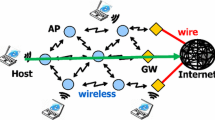Abstract
In this paper, an environment-driven cross-layer optimization scheme is proposed to maximize packet forwarding efficiency. The proposed algorithm is aimed to improve the performance of location-based routing protocol in respect of greedy forwarding and avoid void regions for ubiquitous wireless networks. In greedy forwarding mode, we use a new routing metric IAPS which can estimate the forwarding distance, link quality and the difficulty of channel access during the process of the next hop node selection. When the packet forwarding comes into a local minimum, the proposed scheme uses an opportunistic forwarding method based on competitive advantage to bypass the void regions. NS2 simulation results indicate that the proposed algorithm can improve network resource utilization and the average throughput, and reduce congestion loss rate of wireless multi-hop network comparison with existing GPSR algorithm.








Similar content being viewed by others
References
Loganathan, D., & Ramamoorthy, P. (2013). Efficient routing with multicost parameters based DSDV protocol in wireless ad hoc networks. In Proceedings of 2013 pattern recognition, informatics and medical engineering (PRIME), February 21–22, 2013 (pp. 435–439). Salem: IEEE.
Sivakumar, N. R., & Chelliah, C. (2012). Simulation and evaluation of the performance on probabilistic broadcasting in FSR (Fisheye State Routing) routing protocol based on random mobility model in MANET. In Proceedings of the fourth computational intelligence, communication systems and networks (CICSyN), July 24–26, 2012 (pp. 371–376). Phuket: IEEE-CPS.
Ouacha, A., Lakki, N., El Abbadi, J., Habbani, A., et al. (2013). OLSR protocol enhancement through mobility integration. In Proceedings of the 10th international conference on networking, sensing and control (ICNSC), April 10–12, 2013 (pp. 17–22). Evry: IEEE.
Morshed, M. M., Ko, F. I. S., Dongwook, L., et al. (2010). Performance evaluation of DSDV and AODV routing protocols in mobile ad hoc networks. In Proceedings of 2010 4th international conference on new trends in information science and service science (NISS), May 11–13, 2010 (pp. 399–403). Gyeongju: IEEE.
Kwan, H. L., & Datta, A. (2012). An in-depth analysis of the effects of IMEP on TORA protocol. In Proceedings of wireless communications and networking conference (WCNC), April 1–4, 2012 (pp. 3051–3056). Paris: IEEE.
Sheng, L., Shao, J., & Ding, J. (2010). A novel energy-efficient approach to DSR based routing protocol for ad hoc network. In Proceedings of 2010 international conference on electrical and control engineering (ICECE), June 25–27, 2010 (pp. 2618–2620). Wuhan: IEEE-CPS.
Lin, C. H., Yuan, S. A., Chiu, S. W., & Tsai, M. J. (2010). An algorithm to improve routing efficiency of GPSR-like routing protocols in wireless ad hoc networks. IEEE Transactions on Computers, 59(6), 822–834.
Tang, S., Suzuki, R., & Obana, S. (2007). An opportunistic progressive routing (OPR) protocol maximizing channel efficiency. In Proceedings of global telecommunications conference (GLOBECOM), November 26–30, 2007 (pp. 1285–1290). Washington, DC: IEEE.
Okada, H., Takano, A., & Mase, K. (2009). A proposal of link metric for next-hop forwarding methods in vehicular ad hoc networks. In Proceedings of the 6th IEEE consumer communications and networking conference (CCNC), January 11–13, 2009 (pp. 1–5). Las Vegas, NV: IEEE.
Ma, X., Liu, J., & Liu, X. (2006). A greedy smart path pruning strategy for geographical routing in wireless networks. In Proceedings of military communications conference (MILCOM), October 17–20, 2005 (pp. 1326–1332). Atlantic City, NJ: IEEE.
Lee, S., Bhattacharjee, B., & Banerjee, S. (2005). Efficient geographic routing in multihop wireless networks. In Proceedings of the 6th ACM international symposium on mobile ad hoc networking and computing, May 25–28, 2005 (pp. 230–241). Chicago, IL: ACM.
Couto, D., Aguayo, D., Bicket, J., et al. (2011). A high-throughput path metric for multi-hop wireless routing. Wireless Networks, 11(4), 419–434.
KeLiu’s NS2 Code and Q&A. (2010). http://www.cs.binghamton.edu/~kliu/research/ns2code/.
Acknowledgments
This work was supported by National Basic Research Program of China (2013CB329005), National Natural Science Foundation of China (61302100, 61471203), and Specialized Research Fund for the Doctoral Program of Higher Education (20133223120002).
Author information
Authors and Affiliations
Corresponding author
Rights and permissions
About this article
Cite this article
Zhao, H., Zhu, H., Zhang, Y. et al. Environment-Driven Opportunity Forwarding Cross-Layer Optimization for Ubiquitous Wireless Networks. Wireless Pers Commun 92, 1177–1191 (2017). https://doi.org/10.1007/s11277-016-3601-5
Published:
Issue Date:
DOI: https://doi.org/10.1007/s11277-016-3601-5




